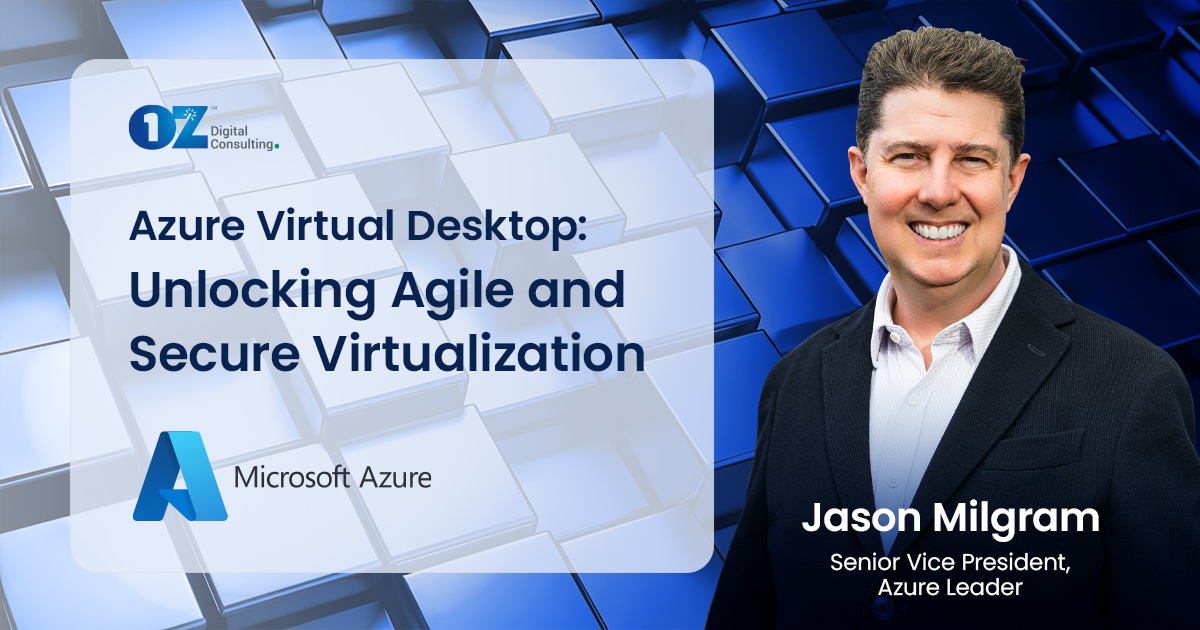By Jason Milgram, SVP Practice Leader, OZ Digital Consulting
As organizations grow and evolve, their needs for flexible, secure, and cost-effective remote desktop services (RDS) become increasingly paramount.
Microsoft’s Remote Desktop Services are the backbone of many organizations’ virtual desktop infrastructure.
Now, however, with the advent of cloud computing, Azure Virtual Desktop (AVD) has emerged as a powerful successor, offering a more agile and secure virtualization solution.
Let’s explore the possibilities…
What is Azure Virtual Desktop?
Azure Virtual Desktop is Microsoft’s desktop and app virtualization service on the cloud. Unlike the traditional on-premises RDS, which requires significant infrastructure and hands-on management, AVD is hosted on Azure, Microsoft’s expansive cloud platform. AVD delivers a virtual desktop experience and remote apps to any device, marrying the scale, security, and cost benefits of Azure cloud services with the familiarity and compatibility of Windows.
Critical benefits of AVD over Microsoft RDS include…
- Enhanced Scalability. AVD stands out with its ability to scale on demand without upfront capital expenditure on physical servers. Businesses can quickly adjust their AVD usage based on user demand, ensuring that they have the resources they need when they need them without overinvesting in server capacity that may go unused.
- Improved Security Features. Security in AVD is bolstered by Azure’s built-in protections, including Azure Firewall, Azure Security Center, Azure Sentinel, and Microsoft Defender for Endpoint. These integrated tools provide a robust defense against threats, reducing the risk of data breaches and ensuring secure connections for remote workforces.
- Cost-Effectiveness. With AVD, organizations only pay for their virtual desktop infrastructure, shifting from a CapEx to an OpEx model. This pay-as-you-go pricing can lead to significant savings, especially when combined with the ability to use existing Windows licenses and reduce the overhead associated with physical hardware maintenance.
- Better Performance Metrics. AVD leverages Azure’s global infrastructure to provide users with high-performance virtual desktops, regardless of location. The service is optimized for Office 365 and Microsoft Teams, ensuring high productivity and a smooth user experience even with high-demand applications.
- Built-in Compliance Protocols. Compliance is a critical concern for businesses, and AVD is designed to meet global and industry-specific compliance standards. With Azure’s compliance offerings, businesses can stay up to date with regulatory requirements, simplify audits, and reduce compliance-related expenses.
- Seamless Integration with Other Azure Services. AVD’s integration with Azure services extends its capabilities beyond traditional RDS. This includes streamlined deployment with Azure Active Directory, automated updates and backups with Azure Backup service, and advanced analytics with Azure Monitor. Such integration not only simplifies management but also enriches the functionality and resilience of virtual desktops.
Planning Your Migration: The POC Approach
Migration to a new virtualization platform is a significant strategic decision for any organization, laden with opportunity and risk. A Proof-of-Concept (POC) is a critical preliminary step in the migration process, providing a structured pathway for businesses to assess the feasibility and benefits of shifting to Azure Virtual Desktop (AVD) from Microsoft Remote Desktop Services (RDS).
This POC approach enables decision-makers to gain firsthand insights into the impact of migration on their operations, workforce, and bottom line. This section introduces the POC strategy and outlines how it is a fundamental tool for risk mitigation and efficient resource allocation.
So, what precisely does that entail?
A POC strategy is a targeted approach to validate the technical and business case for migrating to AVD. It involves creating a miniature, controlled version of the AVD setup to run parallel with existing RDS deployments. The POC strategy is designed to test specific scenarios and workloads, providing an evidence-based assessment of how AVD performs under real-world conditions.
POC as a Risk Mitigation Tool
By its nature, a POC serves as a risk mitigation tool, allowing organizations to:
- Test AVD’s compatibility with existing applications and workloads.
- Evaluate the user experience without disrupting current operations.
- Identify potential challenges and technical constraints early in the process.
- Train IT staff on AVD management in a non-critical setting.
It ensures that potential issues can be addressed before a full-scale rollout, thus safeguarding the organization from the more significant risks associated with a wholesale, untested migration.
The Strategic Importance of POC in Resource Allocation
Implementing a POC has strategic implications for resource allocation:
It clarifies the type and amount of Azure resources required, enabling more precise budgeting and forecasting.
Which is to say…
- Decision-makers can assess the actual cost versus projected cost savings, ensuring that the migration delivers on its promise of cost-effectiveness.
- The organization gains valuable insights into the skills and training their IT team will need, allowing for targeted development and efficient use of human resources.
The POC thus acts as a blueprint for allocating financial, technical, and human resources effectively, ensuring the organization is well-prepared for a successful migration to AVD. In the subsequent section, we will explore how to plan and execute a POC, ensuring that your migration to Azure Virtual Desktop is strategically sound and practically viable.
The POC Phases for AVD Migration
A well-structured Proof-of-Concept (POC) is the cornerstone of any successful migration to Azure Virtual Desktop (AVD).
The process of a POC is broken down into distinct phases, each with its objectives and deliverables that help shape the eventual decision-making and execution of a full migration.
Through these phases, organizations can systematically uncover the intricacies involved in the transition, ensuring a thorough understanding and preparation for the shift to AVD.
Let OZ guide you, the business decision-makers, through each critical phase of a POC, from initial planning to post-POC assessment:
- Pre-POC Phase: Defining Objectives and Scope. The Pre-POC phase is foundational, setting the stage for a successful trial. During this phase, clear objectives for the POC must be outlined, including technical goals, business outcomes, and specific success criteria. The scope of the POC also needs to be defined, determining which applications, processes, and user groups will be included in the test.This phase ensures that the POC aligns with the organization’s strategic goals and sets clear expectations for what it intends to achieve.
- Execution Phase: Setup, Configuration, and Deployment. The execution phase is comprised essentially of three elements.
First, a technical setup, which involves creating the AVD environment within Azure, provisioning virtual machines, and configuring network connections. It is a phase where IT teams get hands-on with the technology, setting up the necessary infrastructure to support the desktops and applications that will be part of the POC.
Next comes user experience testing, assessing how end-users interact with the AVD. Factors such as application responsiveness, desktop load time, and ease of access are evaluated to ensure the system meets the end-users’ needs and expectations.
Finally, we have security testing, which is crucial, particularly when dealing with data and access across the cloud. This step involves verifying that all security measures are functioning as intended, including identity management, data protection, and threat mitigation capabilities.
- Review Phase. Once the execution phase is complete, the review phase begins. This involves collecting and analyzing data on how well the AVD performed against the POC’s objectives. Feedback from end-users, IT administrators, and security teams is gathered to gain a comprehensive view of the platform’s performance and identify any improvement areas.
- Post-POC Phase: Evaluation and Readiness for Full Scale-Up. The final phase is the post-POC evaluation, which is critical in determining the readiness for a broader rollout. It involves thoroughly analyzing the POC results, comparing them against the defined success criteria, and assessing the organization’s ability to support AVD at scale.
Learnings from the POC are used to refine the migration strategy and to develop a clear, detailed roadmap for the full implementation of Azure Virtual Desktop.
Throughout these phases, the organization can build confidence in its migration decision, backed by solid evidence and a well-tested plan. The following section will provide business leaders with a blueprint of the deliverables and outcomes of the POC.
POC Deliverables and Expected Outcomes
Transitioning to a new IT infrastructure is a journey paved with careful planning, evaluation, and strategic decision-making.
A Proof-of-Concept (POC) for Azure Virtual Desktop (AVD) is no exception and is critical for validating the decision to migrate. The deliverables and outcomes of a POC provide tangible evidence and actionable insights, guiding business leaders through the final decision-making process. These deliverables are the hard data and qualitative feedback necessary for informed decision-making. This section outlines the essential POC deliverables that decision-makers can expect to gather and how to interpret these outcomes to map out a migration strategy that aligns with business objectives.
Detailed performance reports—providing quantitative data on AVD’s operation, including load times, latency figures, resource utilization, and application performance metrics—are crucial for understanding how well AVD meets the technical demands of the organization.
These may include…
- Security Assessment. A comprehensive security assessment will reveal the security posture of the AVD setup, detailing how well it integrates with existing security protocols and where enhancements may be needed.
- User Satisfaction Surveys. End-user feedback is essential to gauge the practicality and usability of the AVD solution. Surveys and interviews can provide invaluable insights into the user experience, indicating areas for improvement and overall satisfaction with the virtual environment.
- Cost-Benefit Analysis. A cost-benefit analysis compares the financial investment required for AVD against the expected returns. This includes analyzing savings from reduced hardware, operational efficiencies gained, and potential productivity increases.
So, how can understating POC outcomes benefit your organization?
- Better Decision-Making Data Points. The data collected during the POC phase serve as a critical input for decision-making. These data points cover performance, user experience, security, and cost, providing a 360-degree view of the migration’s feasibility.
- Identifying Potential Roadblocks. A POC can uncover technical and operational challenges that might not have been anticipated. Identifying these roadblocks early allows for contingency planning and informed decision-making.
- Recommendations for Full Deployment. Based on the POC findings, the final report will include tailored recommendations for deploying AVD across the organization. This can range from technical adjustments to training needs for IT staff and users.
Crafting a Migration Roadmap Post-POC
Armed with the knowledge gained from the POC, businesses can develop a comprehensive migration roadmap.
This roadmap will outline the steps for a full-scale rollout, informed by the POC’s deliverables, and will include:
- A timeline for deployment, considering business cycles and peak periods.
- Resource allocation for both the migration process and ongoing operations.
- Training programs for users and IT staff.
- A communication plan to manage change within the organization.
The deliverables from the POC are not merely endpoints but are the critical drivers for a successful digital transformation with AVD at its core.
Your Next Steps
As the adage goes, “The end is only the beginning.”
The conclusion of a Proof-of-Concept (POC) for transitioning to Azure Virtual Desktop (AVD) marks the start of an organization’s journey toward a more agile, secure, and efficient future.
It’s time to place the cutting-edge tools and processes at your disposal that will unlock the true power of your data, drive smarter decisions that improve customer experiences, enhance process efficiency, and skyrocket enterprise innovation.
Learn more here or reach out to schedule a consultation today.



